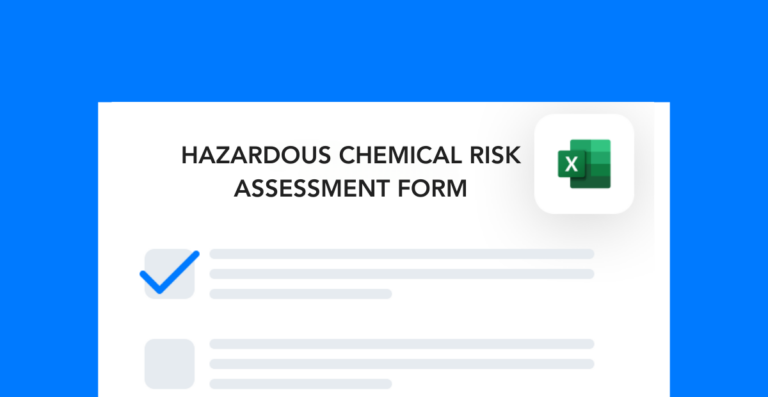The key to controlling oil field hazards is to monitor your preventive measures closely and make changes when necessary. Maintaining a proactive approach ensures that your resources go towards only those strategies that make a difference. Follow these best practices to protect your workers from hazards in the field—both now and in the future.
Free form!
Download this free hazardous chemical risk assessment form to evaluate risks associated with oil field hazards.
Identify the oil field hazards in your operation
You must understand safety risks first if you want to control and eliminate them. Start by breaking down your process into individual tasks. For each task, list out the potential safety hazards workers might encounter, including common oil field hazards. You’ll use this list to come up with control measures.
Here are just a few examples of the oil field hazards you should look for:
Material hazards: Fires, explosions, chemical releases
Equipment hazards: Struck by, caught in or between
Behavioral hazards: Slips and trips, falls, improper PPE use
Environmental hazards: Weather conditions, dust hazards
Next, ask yourself: ‘Have I accounted for all the sources of these hazards?” Think about the equipment you have onsite, which may contribute to oil field hazards, as well as the layout of the rig and other external conditions like weather.
I’d recommend doing a job hazard analysis (JHA) to document your findings. And that’s because during a JHA, you break tasks down into their individual parts and list both the safety hazards and existing control measures.
Audit your oil field hazard control measures
Chances are, you’ve already got control measures in place for the oil field hazards you’ve identified. But for them to be effective, they need to target a specific hazard. Now that you have a list of all the hazards on your rig, it’s time to audit how you’re controlling them.
Criteria for assessing each measure
For each hazard, look at the corresponding control measure(s). Assess each one by asking these questions:
- Is it specifically designed to address this hazard or is it a general measure?
- In the past year, has a failure of this control measure resulted in an incident?
- Do workers follow this safety precaution (if applicable)?
- Does this control measure fully address the hazard or is it a partial solution?
With these questions, you’re trying to determine how effective your control measures are and whether they’re comprehensive. It’s important to have this information about oil field hazards before you make any changes. After all, you don’t want to “fix” strategies that are already working. By evaluating each control measure’s effectiveness individually, you can better figure out where to expend your resources.
Brainstorm and implement improvements
After assessing all your control measures, you should have a good idea of how you want to improve them. The next step in this process is to brainstorm ways to improve your hazard control strategy, particularly for oil field hazards. These are the decisions you want to make:
- Which hazards to address first
- How to improve existing control measures
- Where to introduce brand new measures
- Where to eliminate existing control measures
Once you’ve come up with a game plan, you need to implement your solutions. I always start by addressing the highest-risk areas of the rig, focusing on oil field hazards. For me, these are usually equipment and environmental hazards.
Use your EHS software system to document and track all your action items. That way, you’ll be able to oversee implementation and create a thorough log of all control measures at the same time.
Frontline EHS for oil and gas companies
Learn how you can use Frontline EHS to coordinate and document oil field safety incidents, managing oil field hazards effectively.
Remember, it’s just as important to eliminate poor strategies as it is to implement good ones. In the oil and gas industry, there are a lot of external factors, like oil field hazards, that can impact performance. So, it’s even more essential to eliminate waste where possible.
By removing ineffective control measures, you can refocus resources towards more meaningful strategies in addressing oil field hazards. If your team does a good job of anticipating and controlling hazards before they cause incidents, that has major cost saving benefits.




